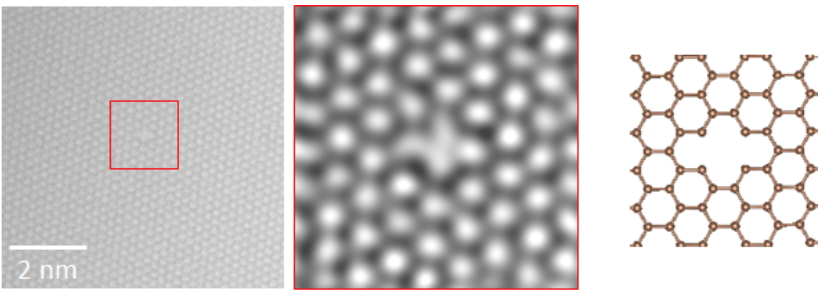The introduction of nanoscale pores in graphene has emerged as a way to develop high-performance separation membranes for a large variety of applications that involve water purification, gas filtration, chemical separation, and DNA sequencing
[1]. Graphene is considered as an ideal membrane especially for nanopores from sub-nanometric to several tens nanometer size to realize promising architectures for wide range of application thanks to its atomically thin nature
[2]. Especially natural gas separation and hydrogen production are one of the important and indispensables processes, which can be resolved by the use of graphene membrane. However sub-nanometer scale nanopores are required for hydrogen gas filtration application and functional membranes are still far from realization because of difficulties in sophisticated control of structure and geometry required for precise selectivity for targeted applications
[3].
In this PhD thesis, we aim to develop new process to create sub-nanometer scale nanopores in graphene. The final objective is to realize size and density-controlled stable nanopores in graphene monolayers and to investigate the membrane performance in test devices for gas filtration applications.
The fabrication of nanopores will be performed using scalable plasma technology in collaboration with
CNRS-LTM. The candidate will study the impact of plasma on graphene monolayer and their dynamics using an atomic resolution imaging by
Low-Voltage Aberration Corrected Transmission Electron Microscopy (LVAC-TEM) in
CEA-IRIG. Recent progress in atomic scale imaging in LVAC-TEM offers great opportunities for atom-by-atom analysis of monolayer graphene including edge structures, which provides an important understanding on structural feature of graphene for its atomic scale engineering
[4-5].

Figure: Vacancy type defect in graphene monolayer observed by LVAC-TEM. The lack of two carbon atoms implies a hole > 3 Å.
© CEA-INAC
The first objective of this thesis work is to achieve a
graphene membrane with density controlled sub-nanometer nanopores via plasma induced defect formation. The realized building blocks will be tested in a device structure for hydrogen gas separation in collaboration
with CEA-LITEN and which will be an important part of thesis in order to study their selectivity. The mechanism of enlargement of sub-nanometer pores via an etching of edges will be then studied to enable fabricating
size-controlled nanopores up to several nanometers. In addition to the plasma process study,
in-situ electron irradiation and real-time observation will be used to investigate atomic scale size modification behaviors. Enabling to fabricate size and edge structure controlled nanometer scale pores in graphene opens up opportunities of biosensing applications such as DNA and protein sequencing. Moreover
other semiconducting 2D layers such as MoS2 will be tested to explore new functionalities for membrane based applications.
The candidate has access to plasma technology in LTM for nanopore fabrication. He (she) will work in INAC group at Nano Characterization Platform (PFNC) using state of the art microscope (Titan ultimate) to investigate atomic structure of nanopores by atom-by-atom (S)TEM imaging including real-time in-situ observation and also work in LITEN to test device performances integrating controlled nanostructures to correlate fundamental structural study to filtration performances to demonstrate new robust technology for nanopore fabrication in graphene.

Laboratory: Laboratoire de l’Etude des Matériaux par Microscopie Avancée (LEMMA), IRIG/MEM/CEA-Grenoble

Supervisors: Dr.
Hanako Okuno (CEA/IRIG)
Dr.
Hélène Le Poche (CEA/LITEN)

Director: Dr.
Gilles Cunge (CNRS/LTM)